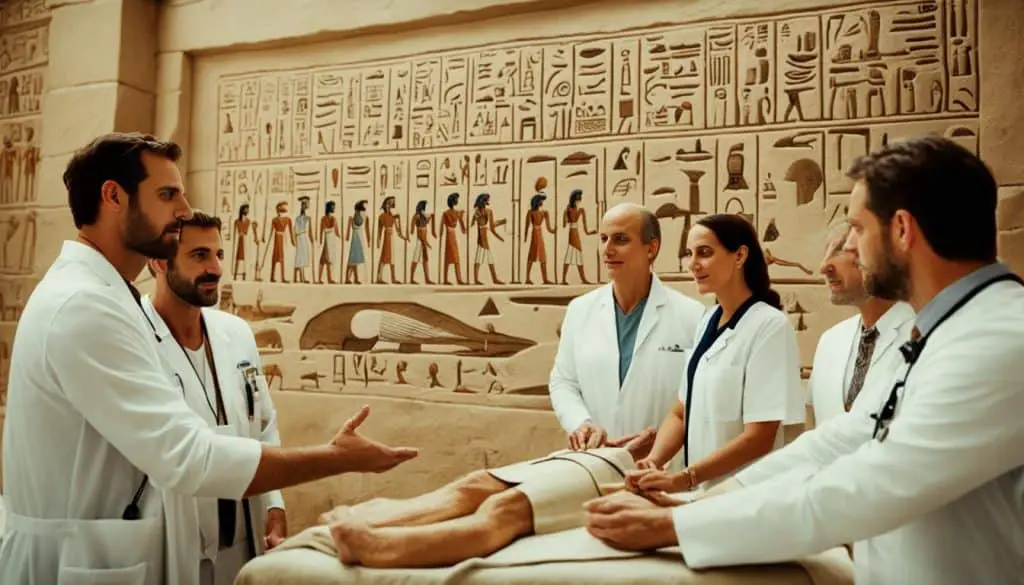Table of Contents
Ever thought about healers and doctors in the Bible? We will look at how they mixed faith and medicine. It’s interesting to see how healing is a key theme in biblical stories.
The Bible shows healing is both physical and spiritual. It combines faith and medical help through various people. The examples range from God as the main healer to everyday folks like the Samaritan.
This article looks at healers and doctors in the Bible. We will discuss key figures like Joseph, Job’s friends, and Luke the Evangelist. Also, we will explore early Christian healings.
Together, we’ll dive into the Bible’s insights on faith and medicine. This journey will give us new perspectives on healing in our modern world.
God Himself as the Ultimate Healer
The Bible calls God the ultimate healer. Many texts show His power and heart in healing those who believe. In Exodus 15:26, God says, “I am the Lord your healer.” This shows that God is the main source of healing, for the body and spirit.
In Psalm 103:3, we read, “He who forgives all your iniquities, who heals all your diseases.” This line tells us God can heal more than our bodies. He can also heal our hearts and minds. His healing works in every part of us, renewing us all.
“I am the Lord your healer.” – Exodus 15:26
“He who forgives all your iniquities, who heals all your diseases.” – Psalm 103:3
Thinking of God as our ultimate healer is very comforting. It tells us He knows our pains and can heal us. This healing includes both our bodies and our hearts. Trusting Him invites His complete healing touch into our lives.
Faith-Based Healing
God’s healing is closely connected to faith. In the Bible, many found healing when they believed in God. This shows that God uses faith and even medicine together for healing.
The Power of Prayer
It’s essential to seek medical aid, but faith and prayer are also key in healing. Praying connects us to God’s love and healing power. It lets us share our worries and find hope and peace in Him.
Trusting in God’s Timing
Wishing for instant healing is natural, but trusting God’s timing is key. He always knows what’s best. Sometimes, getting better takes time and faith in God’s plan.
God’s healing is about more than fixing our bodies. It’s about healing our souls, renewing our minds, and strengthening our spirits. Through His love, God offers a complete healing. He mends every part of us, making us whole.
Physicians in Egypt
In the Book of Genesis, it’s noted that there were physicians in Egypt during Joseph’s time (Genesis 50:1-2). This shows a strong medical knowledge base existed alongside faith healing in ancient times. Even long ago, doctors were vital in treating people.
Physicians in Egypt mixed scientific medicine with faith healing. They used both prayers and medical treatments to help people get better. This mixed approach allowed for complete care.
In ancient Egypt, doctors were highly skilled in using herbs, performing surgeries, and providing remedies. They knew how to bandage wounds, fix broken bones, and heal infections. These doctors were very respected.
Also, Egypt had a well-organized medical system. This shows how much the ancient Egyptians valued their health. Their focus on health led to great strides in medical studies and care.
“The presence of physicians in ancient Egypt emphasizes the coexistence of faith and medicine, showcasing the significance of both in the pursuit of healing and well-being.”
Egyptian physicians offered more than just medical help. They provided comfort and advice too, aiming for a patient’s overall wellness. They focused on both treating and preventing diseases.
Medical Knowledge in Ancient Egypt
The knowledge of medicine in ancient Egypt was very advanced. Doctors there were skilled in areas like eye care, teeth care, and treating stomach issues. They had special treatments for many health problems.
Table: Medical Specializations in Ancient Egypt
| Specialization | Treatment Areas |
|---|---|
| Ophthalmology | Eye diseases and injuries |
| Dentistry | Oral health and dental care |
| Gastroenterology | Stomach and digestive disorders |
| Obstetrics | Pregnancy and childbirth |
These branches of medicine show how much they knew about the body in ancient Egypt. Doctors focused on each part of the body, showing their care for their patient’s health.
Back in biblical times, doctors were an essential part of health care in Egypt. The balance of faith with scientific medicine was key in their healing. This historical role shows the value of combining both approaches today.

Job’s Friends and the Role of Physicians
When tough times hit, we often turn to friends for help. In the story of Job from the Bible, friends had a big part, but they didn’t always say the right things. Eliphaz, one of Job’s friends, knew doctors could help in healing.
Job once said in Job 13:4, “You, however, smear me with lies; you are worthless physicians, all of you!” He talked about the value of doctors’ care even while he suffered.
“You, however, smear me with lies; you are worthless physicians, all of you!”
– Job 13:4
This shows how important it is to consider medical help for healing, especially in hard times. It shows that having both faith and using medicine is good for our health.
Job’s story is a good lesson. It tells us that true healing needs many things. Gifts of faith and kindness are key. But, recognizing doctors’ knowledge is just as important.
| Key Points | |
|---|---|
| 1. Support from friends: | Job’s friends were very important, giving him love and advice when he was down. |
| 2. Acknowledgment of physicians: | Eliphaz knew how doctors could help heal. This says that faith and medicine can go together. |
| 3. Seeking medical help: | Job understood the value of seeing a doctor for getting better, showing that it’s okay to ask for help. |
King Asa and the Coexistence of Faith and Medicine
King Asa was known for his strong faith in God and his dedication to the Lord. A story in 2 Chronicles 16:12 sheds light on his life. He suffered a severe foot disease but reacted in an unexpected way.
Instead of only praying for a miracle, he turned to doctors for help. This action shows the importance of balancing faith and medical care for healing.
Turning to physicians, King Asa understood an important concept. He knew that while faith was critical, God often uses the skills and knowledge of healthcare providers for healing. This event highlights a peaceful relationship between faith and medicine.

“By seeking the aid of physicians, King Asa’s actions reveal the significance of integrating faith and medical practices. Rather than discounting the capabilities of human medicine, King Asa recognized that faith and medicine can work together, aligning with God’s plan for healing.”
King Asa’s story informs us that faith and medicine can work together. They don’t compete but instead enhance each other, providing a complete healing process. By embracing both, we care for our body, mind, and soul.
Benefits of Integrating Faith and Medicine
- Enhanced trust in medical professionals and the healthcare system
- Greater peace of mind and emotional well-being during treatment
- Reduced stress and anxiety through faith-based coping mechanisms
- Increased hope and resilience through the power of prayer
- Improved collaboration between healthcare providers and patients
- Support for the mind, body, and spirit for a well-rounded healing journey
In conclusion, King Asa’s choice to include medical help in his journey shows how faith and medicine can coexist. This mix offers a more complete and balanced approach to healing. It recognizes the importance of both faith and the skills of medical professionals.
| Key Takeaways |
|---|
| King Asa sought the help of physicians when he was sick, recognizing the importance of both faith and medical practices in the pursuit of healing (2 Chronicles 16:12). |
| Integrating faith and medicine allows for a comprehensive approach to well-being, addressing the physical, emotional, and spiritual aspects of health. |
| The coexistence of faith and medical practices can lead to enhanced trust, peace of mind, reduced stress, increased hope, improved collaboration, and comprehensive support for the healing journey. |
Luke the Evangelist, Physician, and Follower of Jesus
In the Bible, we find Luke, a unique figure who blended faith and medical expertise. Luke, known as a physician, was also a key figure in Jesus’ circle. He wrote the Gospel of Luke.
Colossians 4:14 calls Luke “the beloved physician,” highlighting his medical knowledge. This fact deepens the story of healing and faith in the Bible.
Colossians 4:14 (ESV): “Luke the beloved physician greets you…”
Luke’s Gospel shares the connection between faith and the practice of medicine. He recounts Jesus’ miracles that heal people. This shows Luke valued medical knowledge in spiritual healing.
Luke combined his faith with knowledge of medicine. He saw healing as holistic. Luke understood the path to both physical and spiritual health.
Luke’s Contributions in the Gospel of Luke
The Gospel of Luke highlights Jesus’ healings. Luke’s insights, due to his medical background, give a full view of faith healing the sick.
- Healing of the blind: Luke 18:35-43
- Healing of the paralyzed man: Luke 5:17-26
- Healing of the woman with the issue of blood: Luke 8:43-48
Luke shows faith and medical knowledge work together in healing. He offers a complete view of health, connecting the physical, emotional, and spiritual aspects of a person.

| Contributions of Luke the Evangelist | Key Verses |
|---|---|
| Integration of faith and medicine | “Luke, the beloved physician, greets you” |
| Emphasis on holistic healing | “And a woman was there who had been subject to bleeding for twelve years, but no one could heal her.” |
| Documentation of Jesus’ miraculous healings | “Jesus said to him, ‘Rise and go; your faith has made you well.'” |
Luke’s work supports those looking at faith and medicine together for health. His writing bridges faith’s power with medical understanding, promoting a well-rounded view of health.
The Samaritan in the Parable of the Good Samaritan
In Luke 10:25-37, the Parable of the Good Samaritan highlights compassion and practical help. It’s not about being a doctor but showing care and empathy that heals.
It’s the story of a man attacked and left half-dead. A priest and a Levite avoided him, but a Samaritan, usually looked down on, stopped to assist.
The Samaritan’s care wasn’t just words; he acted immediately. He dressed the wounds, used oil and wine for comfort, and then took the man to an inn. There, he ensured ongoing help and paid for it.
“Which of these three, do you think, proved to be a neighbor to the man who fell among the robbers?” He said, “The one who showed him mercy.” And Jesus said to him, “You go, and do likewise.” (Luke 10:36-37)
This story shows that anyone, not just doctors, can aid healing through compassion and practical action. It shows that recovery involves more than just medicine; it’s about emotional and spiritual support too.

Even in a world valuing titles and skills, the Parable of the Good Samaritan highlights the power of love. It shows that anyone can make a big difference with simple acts of kindness. No matter who we are, we can be like the Samaritan by helping, comforting, and caring for others.
| Key Lessons from the Samaritan’s Actions |
|---|
| Compassion is a powerful healing tool. |
| Practical aid plays a vital role in the healing process. |
| Kindness and empathy promote emotional and spiritual well-being. |
| Everyone can make a difference, regardless of their medical expertise. |
Early Church Healings
The Book of Acts shows us the early church experienced amazing healings. Apostles and believers healed people. This is a testament to God’s power and the role of faith in healing.
In Acts 3:1-10, a man unable to walk from birth received healing through Peter and John’s faith. By calling on Jesus, the man’s legs were restored, marking a powerful act of faith’s power.
Acts 9:33-34 tells us about Aeneas, paralyzed for eight years. Apostle Peter prayed in Jesus’ name, and Aeneas was immediately healed. This miracle also showed faith’s transformational strength.
The healings in the Book of Acts point to God’s ongoing power in the early church. They point out how faith and prayer are powerful in seeking healing. These stories encourage us to rely on God’s faithfulness and power for our own healing journeys.




